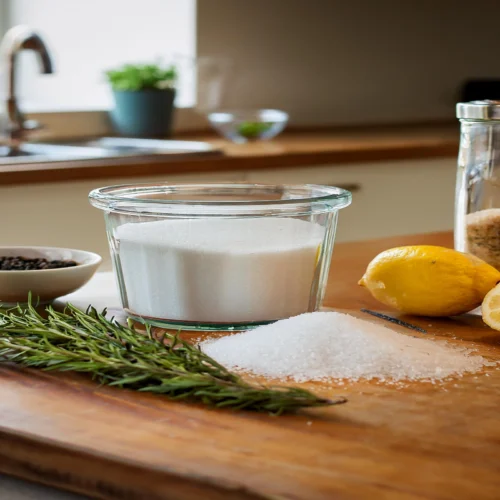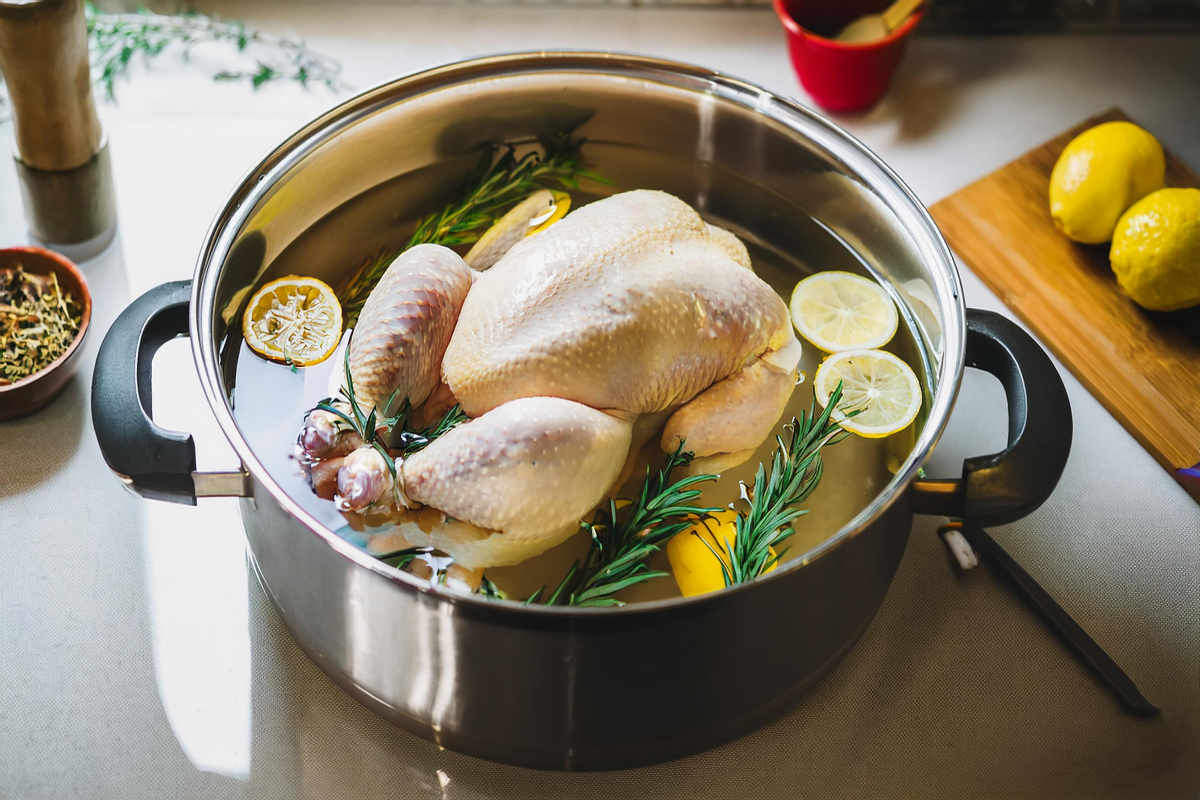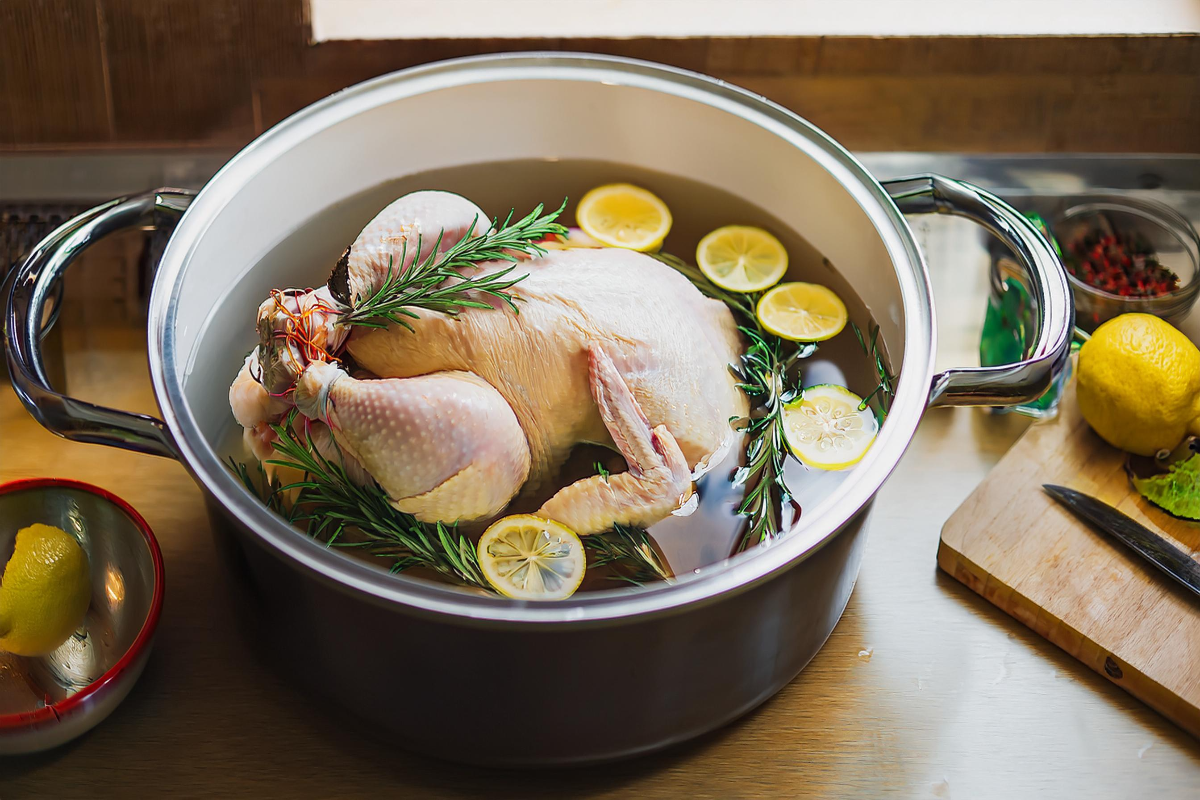Brining chicken is an age-old technique that can, indeed, truly transform your meals. Whether you’re roasting, grilling, or frying, brining helps to retain moisture and significantly enhances the flavor of the chicken. Therefore, in this article, we will walk you through the complete chicken brine recipe, providing all the techniques you need to master it. And, if you’re looking for additional chicken-based dishes, you should also check out our rotisserie chicken recipes for even more delicious ideas.
What is Brining?
Brining, essentially, is the process of soaking meat in a mixture of water, salt, and often sugar. The result? A juicy, flavorful bird that stays tender even when subjected to high heat. But how exactly does brining work? Well, it’s all about osmosis. The salt penetrates the meat, which helps it retain moisture, something that is crucial for maintaining the juiciness of the chicken. Additionally, you can learn more about flavor profiles with our goulash recipe, another dish that benefits from slow flavor infusion.
Why You Should Brine Chicken
Brining is essential for one simple reason: it boosts both flavor and texture. Chicken, especially lean cuts like breasts, tends to dry out very quickly during cooking. Brining helps prevent this by significantly enhancing moisture retention. Some of the key benefits include:
- Retains moisture, even with high-heat cooking.
- Enhances flavor by evenly distributing seasoning throughout the meat.
- Tenderizes the chicken, making each bite even juicier.
Moreover, for more insights on food storage and longevity, you might also find it useful to explore how long cooked chicken can last, such as in our guide on how long rotisserie chicken is good in the fridge.
Different Types of Brines
As you might expect, not all brines are created equal. In fact, there are two main types: wet brine and dry brine. Understanding the differences between them will help you choose the right method for your recipe.
Wet Brine
A wet brine involves submerging the chicken in a saltwater solution. This is, without a doubt, the most common type of brine and works especially well for large cuts like a whole chicken. Here’s how you can make a simple wet brine:
- Ingredients:
- 4 quarts of water
- 1 cup of kosher salt
- ½ cup of sugar
- Optional: herbs like rosemary, thyme, or citrus peels
- First, dissolve the salt and sugar in water.
- Then, submerge the chicken in the solution.
- Brine for 4 to 12 hours, depending on the size of the cut.
For even more ideas on adding flavors, you can explore our post on how to make goulash sauce, which shows how complementary spices can enhance your dishes.
Dry Brine
For those short on time or, perhaps, looking for a simpler option, a dry brine involves rubbing salt and seasoning directly onto the chicken and allowing it to rest in the fridge. This method, importantly, requires less preparation and is ideal for smaller cuts like chicken breasts or thighs.
How Long Should You Brine Chicken?
Brining time, naturally, depends on the cut of the chicken. Too little time and the flavors won’t penetrate deeply enough. On the other hand, too much time, and the meat could become overly salty. Below are some general guidelines:
- Whole chicken: 12-24 hours
- Chicken breasts: 2-6 hours
- Thighs or drumsticks: 2-4 hours
- Wings: 1-3 hours
It’s always a good idea to, afterward, rinse the chicken lightly and pat it dry before cooking to remove any excess salt. Furthermore, for more information on food longevity, you can read our article on how long Costco rotisserie chicken can last in the fridge.
Simple Chicken Brine Recipe
Creating a basic chicken brine recipe is incredibly easy, yet it yields excellent results. Here’s a foolproof guide:

- Ingredients:
- 1 gallon of water
- ¾ cup kosher salt
- ½ cup sugar
- 1 tablespoon peppercorns
- 2 bay leaves
Instructions:
- In a large pot, first dissolve the salt and sugar in the water.
- Then, add in your flavoring agents (peppercorns, bay leaves, etc.).
- Submerge the chicken completely in the brine solution.
- Refrigerate for the recommended time based on the cut.
- Finally, rinse the chicken lightly before cooking.
If you’re looking for more adventurous flavors, why not, in fact, check out our sourdough discard recipes? They can provide a unique pairing for your brined chicken.
Common Mistakes to Avoid When Brining
Even though brining is a straightforward process, certain common errors can easily ruin the results. Therefore, avoid these mistakes to ensure perfect chicken every time:
- Over-brining: This can, as a result, lead to overly salty chicken.
- Not rinsing the chicken afterward: Excess salt can negatively impact the flavor.
- Using table salt instead of kosher salt: Table salt is denser, which could lead to overly salty brine.
For a deeper dive into the science of why brining works, you should also check out the Science of Brining over at Serious Eats.
Advanced Brining Techniques

Once you’ve mastered the basics, it’s time to explore more advanced techniques that can, undoubtedly, truly elevate your chicken.
Adding Extra Flavors to Your Brine
While the classic salt-sugar-water solution is fantastic on its own, adding extra ingredients can take your brine to the next level. Consider adding the following:
- Fresh herbs like thyme or rosemary
- Citrus such as lemon or orange slices
- Aromatics such as garlic or ginger
By experimenting with different flavors, you can, thus, customize the brine to suit the type of cuisine you’re preparing.
Brining for Different Cooking Methods
Not all cooking methods, it should be noted, work equally well with brined chicken. Here’s a breakdown of how brining interacts with different techniques:
- Roasting: Brining for roasting ensures that you get that perfect crispy skin.
- Grilling: Helps prevent the chicken from drying out over direct heat.
- Frying: Keeps the meat moist even after being exposed to the fryer.
Each method may require a slight adjustment in brining time, but the results are guaranteed to be delicious. For more cooking ideas, especially involving smoked flavors, check out our Traeger recipes for inspiration.
FAQs About Brining Chicken
What does brining do to chicken?
Brining helps the chicken absorb moisture and flavor, resulting in a juicier, more flavorful dish.
How long should I brine chicken?
Brining times, naturally, vary depending on the cut. Generally, it ranges from 1 hour for wings to 24 hours for a whole chicken.
Can I brine chicken overnight?
Yes, overnight brining works well, especially for larger cuts like whole chickens. However, be cautious not to over-brine.
What happens if you brine chicken too long?
Over-brining, unfortunately, can make the chicken overly salty and ruin its texture, turning it mushy.
For a detailed step-by-step guide on how to brine chicken, visit The Kitchn.
Storing Brined Chicken
After brining, it’s crucial to store your chicken correctly. Follow these tips to maintain freshness:
- In the fridge: Store brined chicken in the refrigerator for up to 48 hours before cooking.
- In the freezer: If you’re not cooking it immediately, you can freeze the chicken after brining for up to 3 months.
Conclusion: Mastering the Chicken Brine Recipe for Perfectly Juicy Chicken
Brining for Flavor and Tenderness
In conclusion, mastering the chicken brine recipe is one of the most effective ways to ensure your chicken turns out tender, flavorful, and, most importantly, juicy. Whether you’re preparing a whole chicken for a family dinner or just seasoning chicken breasts for a quick weeknight meal, brining makes a noticeable difference in both texture and taste. By soaking the chicken in a mixture of salt, sugar, and water, the meat absorbs moisture and flavors, leading to a much more delicious final product. The best part is, with minimal effort, brining enhances the chicken’s natural qualities, making it more forgiving when cooked at high temperatures.
Experimenting with Brine Ingredients and Methods
Another key takeaway from this process is that brining chicken allows you to introduce a variety of flavors depending on your preferences. For example, adding herbs, spices, and aromatics such as garlic or citrus can further elevate the overall taste profile of the chicken. As we discussed earlier, you can experiment with different brining methods, such as wet or dry brines, to see which one works best for your specific recipe. While a wet brine is great for large cuts like whole chickens, a dry brine is a faster, simpler option for smaller cuts like chicken breasts or thighs. Either way, the result is sure to be a flavorful and tender piece of meat that your family and friends will love.
The Importance of Brining Time and Technique
Ultimately, the secret to achieving perfectly juicy chicken lies in following the correct brining times and techniques. Be sure to allow enough time for the flavors to penetrate the meat, but also avoid over-brining, which can lead to an overly salty dish. With the guidelines outlined in this article, you can confidently prepare any cut of chicken, knowing that your efforts will result in a moist and flavorful dish. Moreover, brining is a technique that can be easily incorporated into your routine for grilling, frying, or roasting. As you continue to refine your skills, you’ll discover that brining is a game-changer when it comes to making chicken taste its best. By mastering the brine chicken recipe, you can ensure every meal featuring chicken is cooked to perfection, making it tender, flavorful, and incredibly satisfying.
Elevating Your Everyday Chicken Dishes
In summary, whether you’re hosting a special occasion or simply preparing a weekday dinner, a well-executed chicken brine is a simple, yet transformative technique that will greatly improve your cooking. It not only keeps the meat moist but also infuses it with layers of flavor that are sure to impress. By understanding the different types of brines, such as wet brine and dry brine, and choosing the best brining time based on the cut of chicken you’re using, you can tailor the process to your liking. In doing so, you’ll elevate even the most basic chicken dishes to new heights, ensuring that they are full of flavor and juicy in every bite. So, go ahead and give brining a try—you’ll be amazed at how this simple technique can turn ordinary chicken into something extraordinary!
